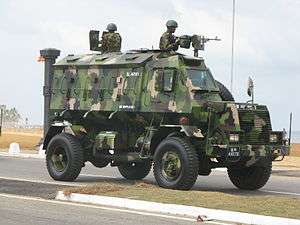Unibuffel
| Unibuffel | |
|---|---|
|
Unibuffel of the Sri Lankan Army | |
| Type | Armoured personnel carrier |
| Place of origin | Sri Lanka |
| Service history | |
| In service | 2000 - Present |
| Used by | Sri Lanka |
| Production history | |
| Designer | Sri Lanka Electrical and Mechanical Engineers |
| Manufacturer | Sri Lanka Electrical and Mechanical Engineers |
| Unit cost | 4 Million rupee[1] |
| Produced | 2000 - Present |
| Specifications | |
| Weight | 6.14 t |
| Length | 5.1 m (16.73 ft) |
| Width | 2.05 m (6.73 ft) |
| Height | 2.95 m (9.68 ft) |
| Crew | 2 + 10 passengers |
|
| |
| Armor | Classified |
Main armament | Twin 7.62mm MG (front) |
Secondary armament | Twin 7.62mm MG (rear) |
| Engine | TATA Diesel Engine |
| Suspension | 4×4 wheeled |
Operational range | 1000 km (621.37 mi) |
| Speed |
Road 96km/h (59.61 mph) Off-road 30km/h (18.64 mph) |
The Unibuffel is a mine-protected wheeled MRAP used by the Sri Lankan military. It can be seen at the Sri Lankan Armoured Corps Museum.
Production history
Although similar to the South African Buffel, it is built entirely by the Sri Lanka Electrical and Mechanical Engineers (SLEME). Used very often by the Sri Lankan forces both as an armoured fighting vehicle and for protection against mines and IEDs and so played a major role in the Sri Lanka civil war. The Unibuffel is the improved version of the Unicorn which was also built by the SLEME. More than 53 Unibuffels had been manufactured as of 2006. The vehicle is powered by a TATA engine which can deal easily with rough terrain.[2]
Combat Usage
The Unibuffel proved quite successful in the Sri Lankan civil war, it could transport troops through rough terrain with ease, and had good protection, it participated in all Sri Lankan Army operations 2005 onwards.
Operators
See also
References
- ↑ Made in Sri Lanka. Retrieved on April 22, 2008.
- 1 2 The evolution of the indigenous armoured vehicle: From Unicorn to Unibuffel Retrieved on April 22, 2008
